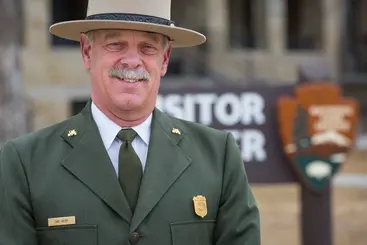Wall, South Dakota—an emblematic fusion of community spirit and global appeal—presents a fascinating story of tourism, workforce challenges, and the unique relationships that define this region. Among its many attractions, Wall Drug stands out, drawing more than 2 million visitors annually with its quirky offerings and rich history. This famed fixture of Wall, a town of roughly 800 residents, combines local charm with international connections, mirroring South Dakota’s broader tourist landscape.

Dan Wenk
Originally founded in 1931 by Ted and Dorothy Hustead, Wall Drug has grown under the stewardship of their great-granddaughter, Sarah Hustead. Known globally for free ice water, 5 cent coffee, and legendary roadside signs, Wall Drug is not only a local treasure but also a critical employment hub. Its staffing model provides insight into the region’s seasonal workforce dynamics.
Seasonal Workforce at Wall Drug
Wall Drug employs about 70 dedicated year-round workers. However, the summer tourist influx necessitates the hiring of approximately 120 additional seasonal employees. This temporary workforce is a diverse assembly of local high school students, traveling work campers, and international workers recruited through H-2B and J-1 visa programs. These visa processes allow foreign nationals to fill temporary, non-agricultural positions, but they are complex and often impacted by bureaucratic delays.
“We really count on those workers,” said Hustead. “Since it’s a lottery system, it’s kind of luck of the draw. It seems like we’re having more trouble after they’ve been approved. To get those visas at the embassies—just everything is taking a little bit longer.”
Wall Drug initiates its H-2B visa applications in October, aiming for early lottery results by January. The J-1 program, in contrast, is relatively expedient and successful, providing Wall with a cultural tapestry woven from Thailand, Kazakhstan, Mongolia, and beyond.
Collaboration Amidst Challenges
Sarah Hustead emphasizes the symbiotic relationship between Wall Drug and its federally managed counterparts, such as Badlands National Park and Mount Rushmore National Memorial. Both attractions heavily depend on seasonal workforces to meet visitor needs, tackling unique obstacles in employment and housing.
Mike Pflaum, special adviser for the nonprofit Badlands National Park Conservancy, connects deeply with the park’s legacy, underscoring its enduring appeal. “Every year we would hire as many seasonal employees as the budget allowed to do everything from fee collection to emergency services,” Pflaum said. Dan Wenk, board member for the Mount Rushmore Society, concurs, emphasizing the need for returning seasonal employees due to their invaluable institutional knowledge.
Housing and Community
Sharing hindsight across these attractions is the challenge of providing adequate housing for seasonal employees. Wall Drug addresses this by owning and managing a trailer court and several houses, thereby enabling comprehensive employee accommodation. Hustead notes, “We own a trailer court in town and have acquired quite a few houses around town, and the management that goes into housing all employees is extensive.”
Federally managed sites like Badlands face similar challenges, prompting workers to seek housing in nearby towns like Interior, Kadoka, and Wall. Despite these hurdles, the mutual support between attractions fosters a collective local economy.
“If I have a customer coming through and they’re not stopping at the Badlands, I’m like, ‘You can’t come here and not go through the Badlands!’” Hustead exclaimed. This camaraderie reflects the broader appeal of South Dakota’s public lands, which increasingly attract amenity migrants drawn by their natural beauty and community lifestyle.
Future of Tourism in South Dakota
Both Pflaum and Wenk have settled in South Dakota to continue promoting and preserving these beloved lands. They observe that migration patterns increasingly favor the region’s rich amenities, positioning South Dakota as a prime destination for both visitors and new residents.
Looking forward, Wall Drug and its peers navigate uncertainties, poised to leverage strong community ties and efficient recruitment programs. As South Dakota sustains its status as a vibrant tourist destination, these efforts remain crucial to maintaining a resilient cultural and economic landscape.
VIEW ‘South Dakota Focus’
For deeper insights into the interplay between South Dakota’s tourist attractions and workforce dynamics, watch the season finale of “South Dakota Focus.” This episode aired on May 29, 2025, on SDPB-TV1 and YouTube, exploring topics such as the impact of workforce challenges on tourism and the pivotal role of housing in staffing.
For more stories and information, visit South Dakota News Watch. Inquiries can be directed to info@sdnewswatch.org.